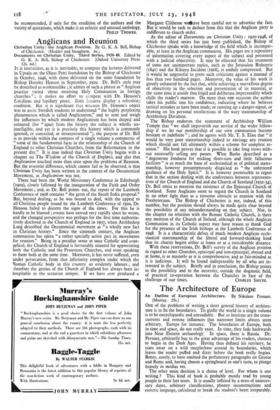The Architecture of Europe
An Outline of European Architecture. By Nikolaus Pevsner. (Murray. 25s.)
ONE of the problems of writing a short general history of architec- ture is to fix the boundaries. To girdle the world in a single volume is to be encyclopaedic and unreadable. But so intricate are the cross- currents and remote influences that narrower limits always seem arbitrary. Europe for instance. The boundaries of Europe, both in time and space, do not really exist. In time, they fade backwards into Near Eastern archaeology! -In space, there is Russia. Dr. Pevsner, arbitrarily but to the great advantage of his readers, chooses to begin- in the Dark Ages. Having thus defined his territory, he tears away on a wild steeplechase around its boundaries, which leaves the reader puffed and dizzy before the book really begins. Better, surely, to have omitted the perfunctory paragraphs on Greece and Rome and, having chosen a springboard to one's taste, to plunge bravely in medias res.
The other main decision is a choice of level. For whom is one writing ? This kind of book is probably mostly read by young people in their late teens. It is usually inflated by a mass of unneces- sary dates, arbitrary classifications, phoney reconstructions and esoteric language, calculated to break the student's heart irreparably.
Dr. Pevsner is that rare bird, an art-historian who remembers that art is for the senses, not the mind. Assuming some text-book know- ledge, he picks out a comparatively tiny number of buildings and tries (one cannot always succeed) not only to fix them in history but to describe what they are like to walk about in. The pedant, whose dismal voice we recognise in a sentence such as this :— " In the West there were before the late 11th century only vaulted apses, tunnel or cross vaulted aisles or narrow tunnel vaulted naves (for instance Naranco) and even smaller tunnel vaulted naves with aisles (St. Martin de Canigou in French Catalonia of 1009 ; in its historical importance enormously overrated by M. Puig y Cadafalch, and the so-called crypt of St. Wipert at Quedlinberg in Saxony of c.930)."
is elsewhere chained and muzzled, and the book is memorable for its many evocations of spatial experiences, such as this ascent of the heavenly (now destroyed) baroque staircase of Bruchsal.
" On the ground floor it is a sombre room, painted with rocks in the rustic manner of Italian grotto imitations. The staircase itself then unfolds between two curved walls, the outside wall solid, that on the inside opened in arcades•through which one looks down into the semi-darkness of the oval grotto. And while we walk up, it grows lighter and lighter around us, until we reach the main floor and a platform the size of the oval room beneath. But the vault above covers the larger oval formed by the outer walls of the staircase. Thus the platform with its balustrade separating it from the two staircase arms seems to rise in mid-air, connected only by bridges with the two principal saloons. And the vast vault above is lit by many windows, painted with the gayest of frescoes and decorated with splendid fireworks of stucco."
Dr. Pevsner seems happiest with Gothic and Baroque, and it is surprising to find the nineteenth and twentieth centuries, on which he is an authority, so summarily dealt with and inadequately illus- trated. (Otherwise, the illustrations are a brilliant collection, and just right in quantity.) There are many curiosities of emphasis in this book. Why bring in America, if not Scandinavia ? Why, if there is no room for Hawksmoor, Gibbs or Gabriel, refer at length to Gilly, who never built anything ? The temptation to exalt the humble and debunk the great is presumably responsible. But one can argue for ever on aesthetic relativity. Better to salute here a book which first as a Penguin and now in John Murray's fine octavo does add appreciably to the pleasures of the eye ; not standing like some beastly Cerberus on the threshold of architecture, but tempting the student, as with the sound of music behind a door, to open it and



































 Previous page
Previous page